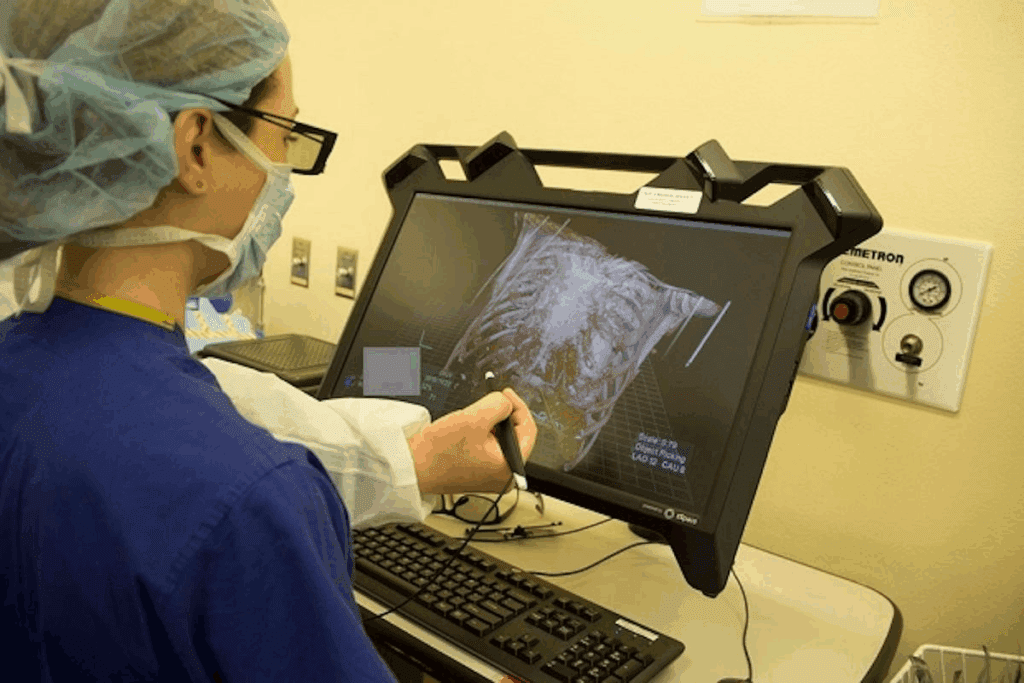
Knowing how blood vessels supply the heart is key to good heart health. At Liv Hospital, we stress the need for a detailed coronary artery diagram. This helps us see how blood gets to every part of the heart.
The coronary circulation is like a crown around the heart. It’s vital for the heart’s work. Knowing about these vessels is important for finding and treating heart problems.

The heart needs its own blood supply to work well. This comes from the coronary circulation. It’s a network of vessels that brings oxygen and nutrients to the heart muscle. This lets the heart function as it should.
We’ll look at why coronary arteries are key and the heart’s blood supply anatomy.
Coronary arteries are blood vessels that go around and through the heart muscle. They bring oxygenated blood that’s vital for the heart to work. These arteries branch off from the aorta, giving the heart what it needs to pump blood.
The role of coronary arteries is huge. They give the heart muscle the oxygen and nutrients it needs to beat and pump blood. If these arteries get blocked or damaged, it can cause serious heart problems.
The heart gets its blood mainly from the coronary arteries, which come from the aorta. These arteries split into smaller ones that go into the heart muscle. They bring oxygenated blood to the heart’s different parts.
Knowing how the heart’s blood supply works is key for diagnosing and treating heart issues. The coronary circulation is complex and needs to work right for heart health. Understanding coronary arteries and their role helps us grasp heart diseases better.

A detailed coronary artery diagram shows the paths and areas that get blood from the heart’s main vessels. The coronary circulation is a network of vessels that feed and drain the heart. It’s key for keeping the heart working right.
Coronary circulation diagrams are key for grasping the heart’s blood supply. They show the big coronary arteries, like the left main coronary artery, left anterior descending artery, and right coronary artery. Doctors use these diagrams to spot blockages or issues in the heart’s blood flow.
To get the most from these diagrams, you need to know the major vessels’ layout. This means understanding where they start, how they go, and what they supply.
The left main coronary artery starts from the left aortic sinus and splits into the left anterior descending artery and the circumflex artery. The left anterior descending artery goes down the anterior interventricular groove. It feeds the heart’s front wall and the front two-thirds of the interventricular septum.
The right coronary artery begins at the right aortic sinus and runs along the right atrioventricular groove. It supplies the right atrium, parts of the right ventricle, and in most people, the posterior descending artery. This artery feeds the heart’s back third.
Knowing where these big vessels are is vital for diagnosing and treating heart disease. By seeing the coronary circulation, doctors can grasp how blockages or problems affect the heart’s function.
The left main coronary artery is key for the heart’s blood supply. It’s also known as the LM heart artery. It starts from the left aortic sinus. We’ll look at its anatomy, how it splits, and what areas it covers.
The LM heart artery begins near the aortic valve. It goes between the pulmonary trunk and the left atrium. The length of the LM heart artery varies greatly, from a few millimeters to several centimeters.
The LM heart artery splits into two main branches: the left anterior descending (LAD) and the circumflex (Cx) artery. The LAD runs down the front of the heart. The circumflex wraps around the left side of the heart. This split is key for blood to reach the left ventricle.
The left main coronary artery system feeds a big part of the heart. This includes the left ventricle, a bit of the right ventricle, and the interventricular septum. The LAD is very important. It supplies the front of the left ventricle and most of the interventricular septum.
We’ve talked about how vital the left main coronary artery is for the heart’s blood flow. Knowing its anatomy, how it splits, and what it supplies is key for treating heart disease.
The Left Anterior Descending Artery (LAD) is key in the heart’s blood flow. It’s called the “widowmaker” because it’s vital for the heart’s front side. Knowing how it works is essential for heart health.
The LAD runs along the heart’s front, reaching the heart’s tip. It supplies blood to the heart’s front and a big part of the wall between the ventricles. This is important for the heart’s function.
The LAD has branches that reach the heart’s side. These branches help ensure the heart’s side gets enough blood. They branch off at different angles from the LAD.
The LAD feeds the heart’s front and a big part of the wall between the ventricles. This is key for the heart’s function. Problems with the LAD can harm the heart’s ability to work.
| Region Supplied | Artery Responsible | Clinical Significance |
| Anterior Wall of Left Ventricle | Left Anterior Descending Artery (LAD) | Critical for left ventricular contraction |
| Anterior 2/3 of Interventricular Septum | Left Anterior Descending Artery (LAD) | Essential for septal function and overall heart rhythm |
| Lateral Wall of Left Ventricle | Diagonal Branches of LAD | Important for lateral wall motion and overall ventricular function |
In conclusion, the Left Anterior Descending Artery is vital for the heart’s blood flow. Its blockage can cause serious problems. This shows how important it is for heart health.
The circumflex artery is a key branch of the left coronary artery. It is vital for the left ventricle’s function. It supplies blood to the lateral and posterior walls of the left ventricle and the left atrium.
The circumflex artery starts from the left main coronary artery. It goes around the heart, following the coronary sulcus to the left. It runs along the left atrioventricular groove, supplying the left atrium and the lateral wall of the left ventricle.
The circumflex artery has several important branches, including the obtuse marginal (OM) branches. These branches supply the lateral wall of the left ventricle. There are many variations in how the circumflex artery branches out, with some being more extensive.
The circumflex artery supplies the lateral and posterior walls of the left ventricle. Its branches, like the OM branches, ensure these areas get enough blood. Sometimes, it also helps supply the posterior descending artery, depending on the heart’s blood flow pattern.
In summary, the circumflex artery is key to the heart’s blood flow. It supports the left heart by supplying blood to the left ventricle’s walls. Knowing its path, branches, and variations is vital for treating heart disease.
Obtuse marginal arteries are key in the coronary circulation. They supply blood to the left ventricle’s lateral wall. These arteries branch off the circumflex coronary artery, playing a vital role in heart muscle blood supply.
These arteries come in different sizes and numbers. Usually, there are one to three branches from the circumflex artery. The anatomy of these branches can significantly impact the perfusion of the lateral wall.
Obtuse marginal arteries have varied origins and paths. But, their main job is to feed the lateral part of the left ventricle.
The obtuse marginal arteries ensure blood flow to the left ventricle’s lateral wall. This area is vital for the heart’s pumping ability. Any blood supply issues here can cause serious problems.
These arteries generally cover the lateral and sometimes the posterior wall of the left ventricle.
| Artery | Origin | Region Supplied |
| Obtuse Marginal | Circumflex Artery | Lateral Wall of Left Ventricle |
| Circumflex | Left Main Coronary Artery | Lateral and Posterior Walls |
Occlusion of the obtuse marginal arteries can cause heart attacks, mainly affecting the left ventricle’s lateral wall. Prompt medical attention is vital to reduce damage.
The effects of OM occlusion include lower heart function and possible heart failure or arrhythmias.
Knowing how obtuse marginal arteries work is key to treating coronary artery disease well.
The right coronary artery is a key vessel that comes from the aorta. It supplies the right ventricle. It’s essential for the health and function of the heart’s right side.
The right coronary artery (RCA) starts from the aorta, just above the right (coronary) semilunar cusp of the aortic valve. It then moves through the atrioventricular groove. It supplies branches to the right atrium and ventricle. Knowing the anatomy of the RCA helps in diagnosing and treating heart diseases.
The path of the RCA varies among people. But, its main job is always the same: to supply blood to the heart’s right side.
The RCA has several important branches, including:
These branches are key for blood supply to the heart’s right ventricle and the posterior septum.
The right coronary artery and its branches mainly supply blood to:
Knowing which areas the RCA supplies is key to understanding its role in heart health and disease.
In summary, the right coronary artery is a vital part of the heart’s blood circulation. It supplies the right side of the heart and is essential for its function.
The posterior descending artery is key for the heart’s lower part. It helps keep the heart’s lower wall and back septum healthy and working right.
In about 70% to 80% of people, this artery comes from the right coronary artery (RCA). But, it can also start from the left circumflex artery in some, mainly when the left coronary artery is dominant.
Where the posterior descending artery starts is important. It affects how blood flows to the heart’s lower and back parts.
This artery goes along the posterior interventricular groove. It supplies blood to the heart’s lower wall and back septum. Its path can change, affecting what areas it reaches.
Its branches reach the left ventricle’s lower side. This ensures strong blood flow to this key area. Knowing how it spreads out helps us understand its role in heart function.
The posterior descending artery feeds blood to the heart’s lower wall and back septum. This is vital for these areas to contract properly.
| Region Supplied | Artery Responsible |
| Inferior Wall | Posterior Descending Artery |
| Posterior Septum | Posterior Descending Artery |
| Right Ventricle (partial) | Right Coronary Artery |
In summary, the posterior descending artery is essential for the heart’s lower and back parts. Knowing where it starts, how it spreads, and what it supplies is key to understanding its importance for heart health.
The pattern of coronary dominance is key to heart health and disease management. It refers to which artery supplies the heart’s inferior wall. This is through the posterior descending artery (PDA).
Most people have right dominance, where the right coronary artery (RCA) supplies the PDA. About 85-90% of people have this pattern. Left dominance, where the left circumflex artery (LCx) supplies the PDA, is less common, found in 7-10% of individuals.
Knowing a patient’s dominance is vital for diagnosis and treatment. It affects how heart disease is managed.
Some people have co-dominance or balanced circulation. Here, both the RCA and LCx supply the inferior wall. This is less common and can make diagnosis and treatment tricky. Co-dominance might offer some protection against heart events but makes angiograms harder to read.
Coronary dominance patterns greatly affect heart disease. For example, in right-dominant individuals, an RCA blockage can cause severe heart damage. In left-dominant individuals, an LCx blockage can have similar severe effects.
Cardiologists must understand these patterns to plan the right treatments. Knowing the dominance pattern helps tailor treatments, improving patient outcomes.
In summary, coronary dominance patterns are critical in heart disease diagnosis and treatment. Recognizing these patterns is essential for the best care of patients with heart disease.
The coronary artery diagram shows how blood flows to the heart. It highlights seven major vessels that supply blood. Knowing this is key for diagnosing and treating heart disease.
The heart’s blood supply comes from a complex network. The left main, left anterior descending, circumflex, and right coronary arteries work together. They ensure the heart gets the blood it needs.
Looking at the coronary artery diagram helps us see how these vessels connect. It shows the areas they supply. This knowledge is vital for treating heart disease accurately.
Healthcare experts use this diagram to better understand and manage heart disease. It helps improve patient care. The diagram is a key tool in cardiovascular care.
A coronary artery diagram shows the heart’s blood vessel network. It highlights the paths and areas that get blood from major vessels.
The main coronary arteries are the left main, left anterior descending, and circumflex arteries. There’s also the right coronary, obtuse marginal, posterior descending, and ventricle artery.
The left main coronary artery is key for heart blood supply. It splits into the LAD and circumflex arteries. These supply the left ventricle and interventricular septum.
The left anterior descending artery, or “widowmaker,” is vital. It supplies blood to the heart’s anterior wall and interventricular septum.
Coronary dominance is the heart’s blood flow pattern. It can be right, left, co-dominant, or balanced. This affects heart disease risk and diagnosis accuracy.
The right coronary artery mainly supplies the right heart side. It feeds the right ventricle and posterior interventricular septum.
The circumflex artery supports the left heart. It supplies the left ventricle’s lateral and posterior walls through its branches.
Obtuse marginal arteries are vital lateral branches of the circumflex artery. They supply the left ventricle’s lateral wall. Their blockage can lead to serious heart issues.
Coronary circulation diagrams help diagnose coronary artery disease. They show the major vessels’ anatomy. This helps identify arteries and blockages.
The posterior descending artery is key for the inferior heart. It supplies the inferior wall and posterior septum.
Knowing the heart’s blood supply is vital for diagnosing and treating heart disease. It helps understand the heart’s complex blood vessel network.
Coronary arteries are essential for the heart. They form a network that delivers oxygenated blood. This is critical for the heart’s function.
National Center for Biotechnology Information. (2025). Coronary Artery Diagram 7 Key Vessels Supplying the. Retrieved from https://pmc.ncbi.nlm.nih.gov/articles/PMC8200569/
Subscribe to our e-newsletter to stay informed about the latest innovations in the world of health and exclusive offers!
WhatsApp us